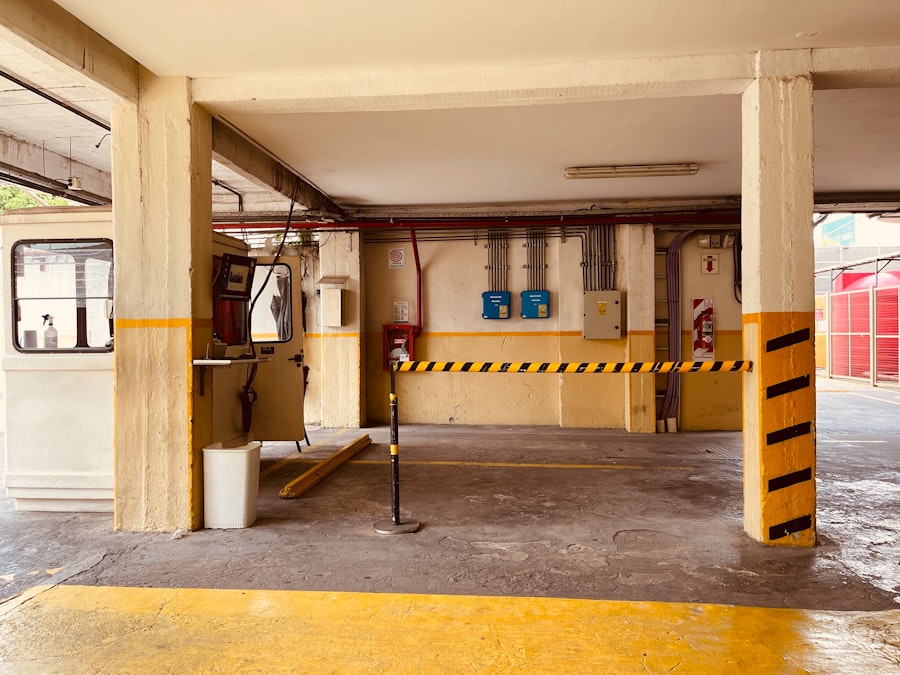Transforming a garage into a functional workspace begins with careful planning and organization. The first step is to assess the available space and determine the specific needs of the workspace. This could range from a simple desk setup for remote work to a more elaborate area for crafting, woodworking, or mechanical repairs.
Consideration should be given to the types of activities that will take place in the garage, as this will influence the layout and design. For instance, if woodworking is a primary focus, ample room for tools, materials, and safety equipment must be allocated. Once the activities are identified, the next step is to create a layout that maximizes efficiency.
This often involves zoning the space into different areas based on function. For example, one corner could be dedicated to a desk and computer setup, while another area could house tools and equipment. Utilizing vertical space is crucial; wall-mounted shelves and pegboards can keep tools organized and easily accessible.
Additionally, ensuring adequate lighting is essential for productivity. Natural light is ideal, but if that’s not possible, bright LED lights can illuminate the workspace effectively. By creating a well-organized and thoughtfully designed workspace, individuals can enhance their productivity and enjoy their time spent in the garage.
Key Takeaways
- Organize your garage by setting up a functional workspace tailored to your needs.
- Maximize storage with shelves, cabinets, and overhead racks to keep the area clutter-free.
- Upgrade your garage door for improved security, insulation, and curb appeal.
- Transform the garage into a home gym or entertainment space to add versatility.
- Incorporate energy-efficient improvements to reduce utility costs and environmental impact.
Adding Storage Solutions
Storage solutions are vital in maintaining an organized garage workspace. Without proper storage, tools and materials can quickly become cluttered, leading to frustration and inefficiency. One effective approach is to incorporate modular shelving units that can be adjusted as needs change.
These units can hold everything from bins of screws and nails to larger power tools. Clear plastic bins are particularly useful as they allow for easy visibility of contents while keeping items protected from dust and moisture. In addition to shelving, utilizing wall space with cabinets or overhead storage can significantly increase storage capacity without taking up valuable floor space.
For instance, installing cabinets above workbenches can provide a convenient place to store frequently used items while keeping them out of sight. Another innovative solution is to use rolling carts or tool chests that can be moved around as needed. This flexibility allows for easy access to tools while also providing additional workspace when required.
By implementing these storage solutions, individuals can create a more functional and efficient garage environment.
Installing a New Garage Door

A new garage door can dramatically enhance both the functionality and aesthetic appeal of a garage space. When considering a replacement, it’s essential to evaluate the various styles and materials available on the market. Steel doors are popular for their durability and low maintenance requirements, while wooden doors offer a classic look that can be customized with paint or stain.
Additionally, insulated doors are worth considering for those living in regions with extreme temperatures, as they help regulate the internal climate of the garage. The installation process itself can vary depending on whether one opts for a DIY approach or hires professionals. For those who choose to tackle the project themselves, it’s crucial to follow manufacturer instructions closely and ensure all safety precautions are taken.
This includes using proper lifting techniques and securing the door correctly to prevent accidents. On the other hand, hiring professionals can provide peace of mind, especially for those unfamiliar with garage door mechanics. A well-installed garage door not only improves functionality but also enhances curb appeal, potentially increasing property value.
Converting the Space into a Home Gym
| Metric | Details | Typical Range | Notes |
|---|---|---|---|
| Space Required | Minimum area needed for equipment and movement | 50 – 150 sq ft | Depends on equipment type and workout style |
| Equipment Cost | Initial investment for basic home gym setup | 200 – 1500 | Includes weights, mats, and cardio machines |
| Setup Time | Time to organize and install equipment | 2 – 8 hours | Varies with complexity and number of items |
| Maintenance Frequency | How often equipment needs upkeep | Monthly to quarterly | Includes cleaning and mechanical checks |
| Noise Level | Typical noise generated during workouts | Low to Moderate | Depends on equipment and flooring |
| Energy Consumption | Electricity used by powered equipment | 50 – 300 kWh/month | Applies to treadmills, ellipticals, etc. |
| Storage Needs | Space for storing equipment when not in use | 10 – 30 sq ft | Important for small living spaces |
Converting a garage into a home gym is an increasingly popular trend that allows individuals to exercise in the comfort of their own homes. The first step in this transformation is to evaluate the available space and determine what type of equipment will be used. For example, if weightlifting is a priority, ample floor space for free weights and benches is necessary.
Alternatively, if cardio workouts are favored, incorporating machines like treadmills or stationary bikes will require careful planning regarding layout and electrical needs. Once the equipment is selected, flooring becomes an important consideration. Rubber flooring is an excellent choice for home gyms as it provides cushioning and absorbs impact, making it safer for workouts.
Additionally, mirrors can be installed on walls to create an illusion of more space while allowing users to monitor their form during exercises. Proper ventilation is also crucial; installing fans or ensuring windows can open will help maintain a comfortable environment during workouts. By thoughtfully designing a home gym in the garage, individuals can create a motivating space that encourages regular exercise.
Building a Custom Workbench
A custom workbench is an invaluable addition to any garage workspace, providing a dedicated area for projects and repairs. The first step in building a workbench is determining its size and design based on the intended use. For instance, someone who works with large materials may require a more expansive surface area, while others may prefer a compact design that fits snugly against a wall.
Selecting high-quality materials is essential; hardwoods like maple or birch are often favored for their durability and resistance to wear. Construction typically involves assembling a sturdy frame using 2x4s or similar lumber, followed by attaching a solid tabletop that can withstand heavy use. Incorporating features such as built-in drawers or shelves can enhance functionality by providing storage for tools and supplies directly within reach.
Additionally, adding vises or clamps can facilitate various tasks, from woodworking to metalworking. A well-built workbench not only serves as a practical workspace but also becomes a centerpiece of creativity and craftsmanship within the garage.
Designing a DIY Workshop

Designing a DIY workshop in the garage allows enthusiasts to pursue their passions in a dedicated environment tailored to their needs. The first step in this process is to define the primary focus of the workshop—whether it’s woodworking, electronics, or automotive repair—since this will dictate the necessary tools and layout. For example, a woodworking shop may require ample surface area for cutting and assembling projects, while an electronics workshop might prioritize workstations equipped with power outlets and specialized tools.
Once the focus is established, organizing tools becomes paramount. A combination of pegboards for hanging tools and drawers for smaller items can create an efficient system that minimizes clutter. Additionally, incorporating task lighting above work areas ensures that projects can be completed accurately and safely.
Ventilation is another critical aspect; workshops often generate dust or fumes that need to be managed effectively through windows or exhaust fans. By carefully designing a DIY workshop that caters to specific interests and activities, individuals can foster creativity and productivity in their projects.
Creating a Playroom or Entertainment Space
Transforming a garage into a playroom or entertainment space offers families an opportunity to utilize this often-overlooked area for leisure activities. The first consideration should be how the space will be used—whether it’s for children’s playtime or as an adult entertainment area with games and media setups. For children’s playrooms, safety becomes paramount; soft flooring options like foam tiles can cushion falls while providing an inviting atmosphere.
Incorporating furniture such as bean bags or low tables creates comfortable seating arrangements suitable for various activities like arts and crafts or board games. For adult entertainment spaces, investing in comfortable seating like recliners or sofas along with entertainment systems can create an inviting atmosphere for movie nights or gatherings with friends. Additionally, adding elements like soundproofing panels can enhance audio experiences while minimizing noise disturbances from outside or other areas of the home.
By thoughtfully designing this space as either a playroom or entertainment area, families can maximize their enjoyment of the garage.
Implementing Energy-Efficient Upgrades
Implementing energy-efficient upgrades in a garage not only contributes to environmental sustainability but also reduces utility costs over time. One of the most impactful upgrades is improving insulation within the garage walls and ceiling. Proper insulation helps regulate temperature, making it easier to maintain comfortable conditions year-round while reducing heating and cooling expenses.
Another significant upgrade involves installing energy-efficient lighting solutions such as LED fixtures that consume less electricity than traditional bulbs while providing brighter illumination. Additionally, considering solar panels for powering lights or small appliances within the garage can further enhance energy efficiency by utilizing renewable energy sources. Upgrading windows to double-glazed options can also improve insulation while allowing natural light into the space without compromising energy efficiency.
By focusing on these energy-efficient upgrades, homeowners can create a more sustainable garage environment that benefits both their finances and the planet.




